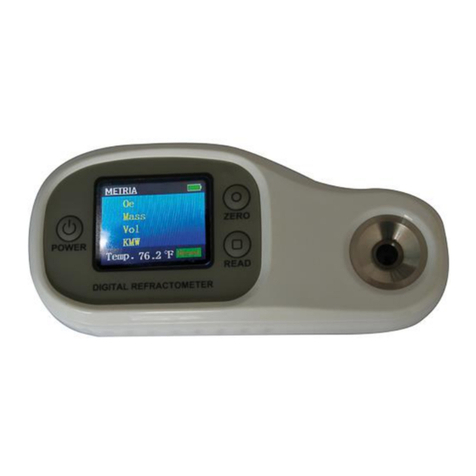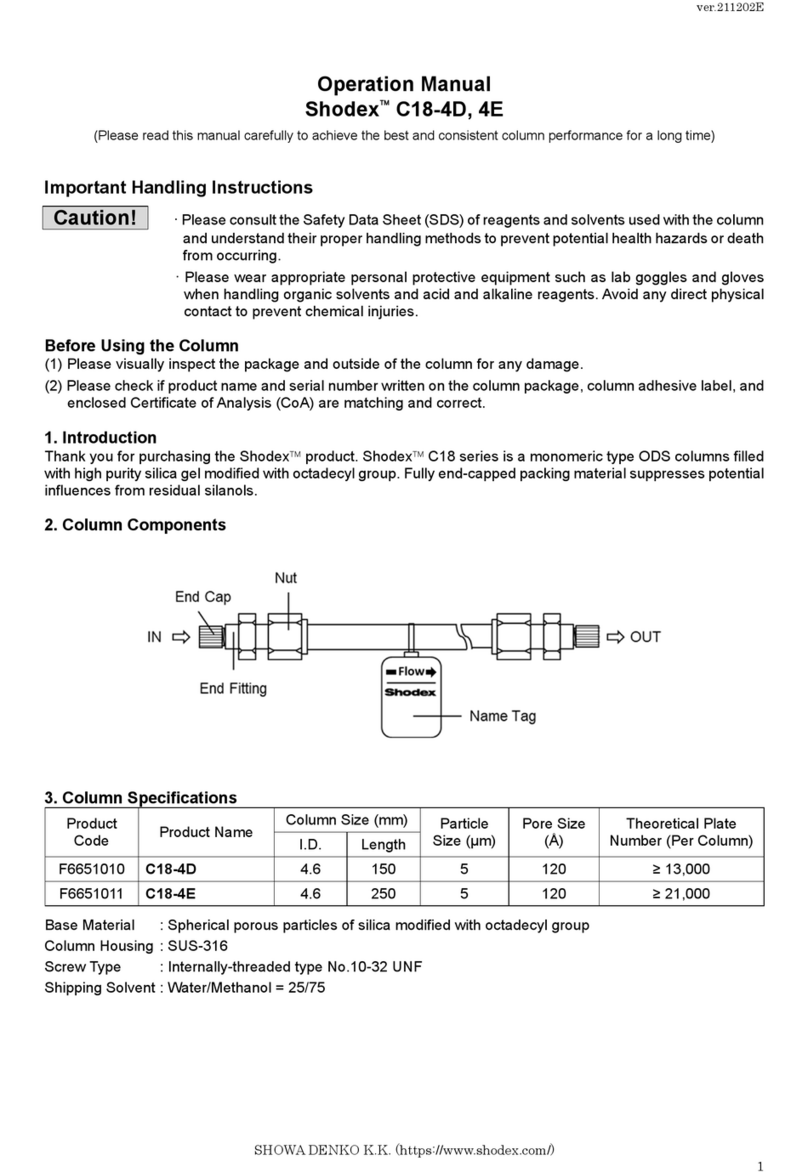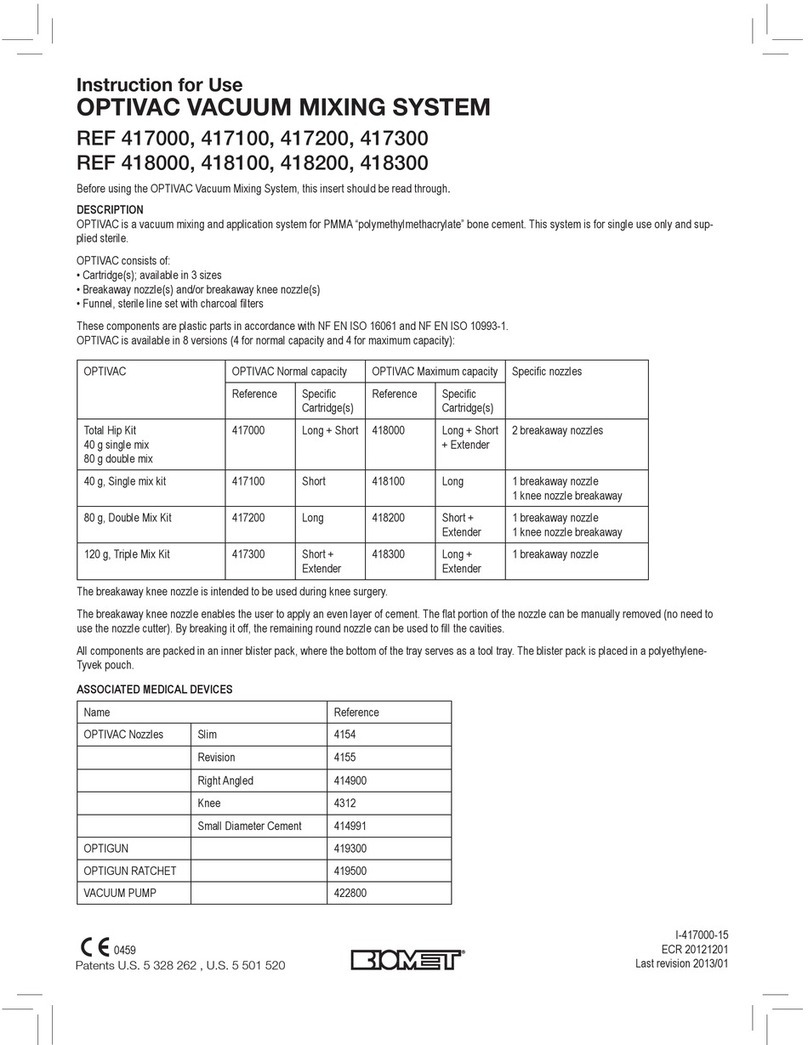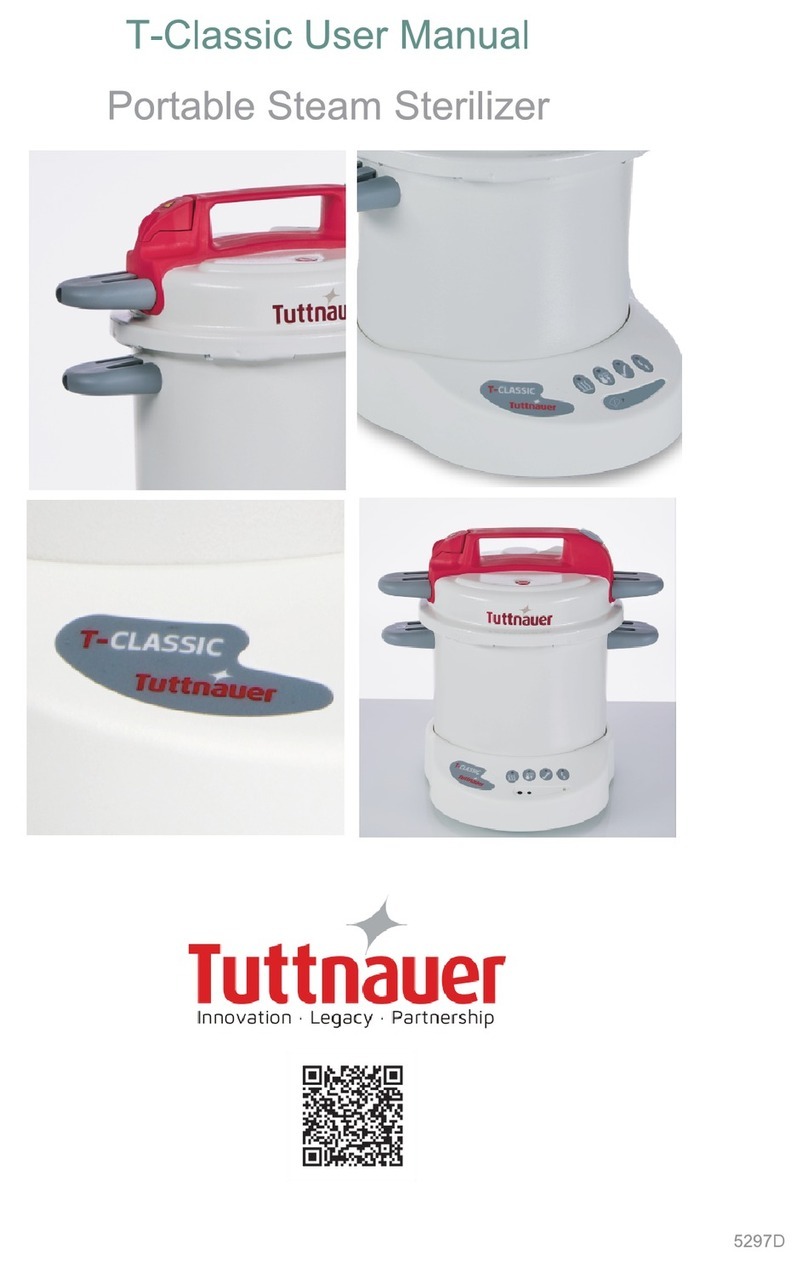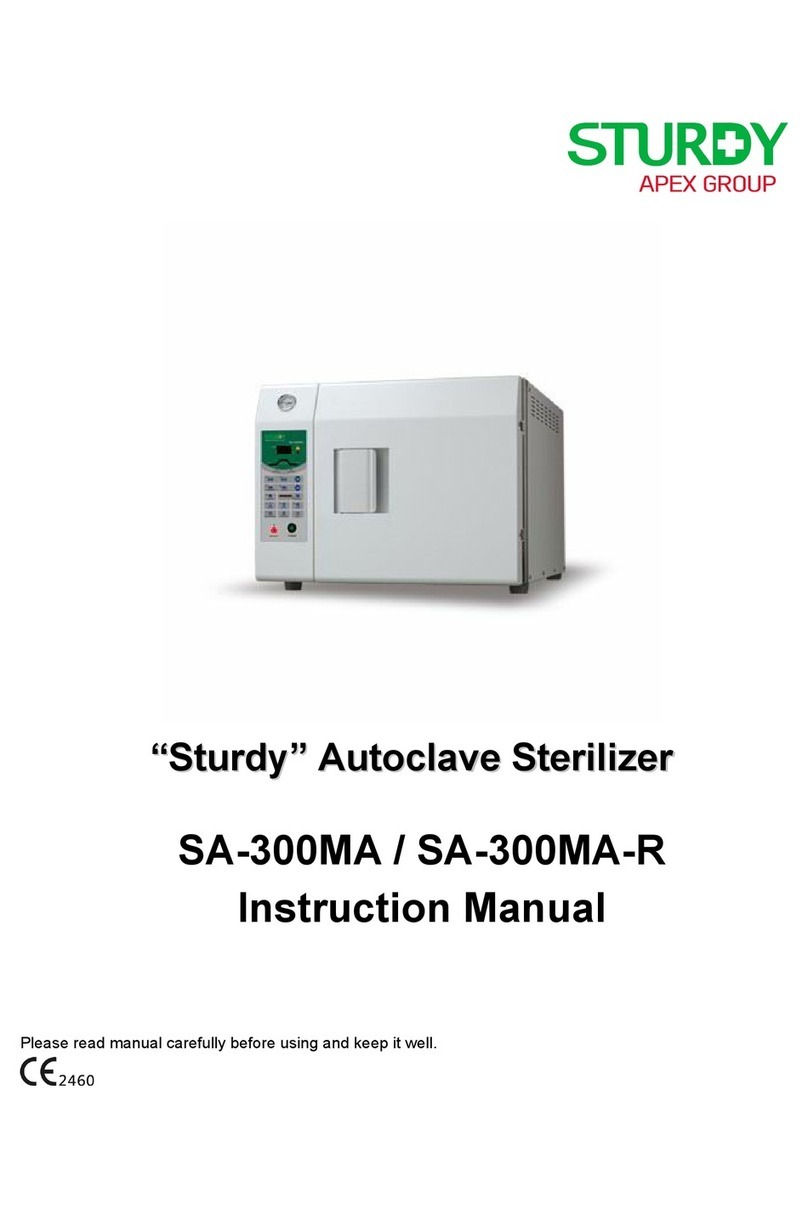Metria RST111 User manual

ABBE Analogic refractometer RST111
Please read the User Manual carefully before use, and follow all operating and safety instructions!
user manual
english

2
User Manual
ABBE Analogic refractometer RST111
Preface
Users should read this manual carefully, follow the instructions and procedures, and beware of all the cautions
when using this instrument.
Service
When help is needed, you can always contact the Service Department of manufacturer for technical support:
www.labbox.com / e-mail: info@labbox.com
Please provide the customer care representative with the following information:
•Serial number
•Description of problem
•Your contact information
Warranty
This instrument is warranted to be free from defects in materials and workmanship under normal use and service,
for a period of 24 months from the date of invoice. The warranty is extended only to the original purchaser. It
shall not apply to any product or parts which have been damaged on account of improper installation, improper
connections, misuse, accident or abnormal conditions of operation.
For claim under the warranty please contact your supplier.

3
1. Safety Instructions
•Please read this manual carefully before installing or operating this equipment. The instrument shall not
be modified in any way. Any modification will void the warranty and may result in potential safety hazard.
We are not responsible for any injury or damage caused by modifying the instrument without authorization.
•If the equipment is used in a manner not specified by the manufacturer, the protection provided by the
equipment may be impaired. The instrument shall not be modified or altered in any way.
•We are not responsible for any injury or damage caused by using the instrument for any non-intended
purpose.
2. Intended use
This refractometer is intended for measuring the refractive index nD and the average dispersion nF - nC of
transparent or translucent liquid, or solid substance (mainly intended for measuring transparent liquid). In case
of the instrument being connected with a thermostat, it will be able to measure the refractive index nD at a
temperature between 0 and 70.
Both, the refractive index and the average dispersion are the important optical constants, through which we
can understand the optical performance, purity, concentration, as well as dispersion of a substance. In this
instrument, based on the formula provided by the International Commission of Uniform Method of Sugar
Analysis (ICUMSA) in 1974, the refractive index is converted into the mass fraction (Brix) of cane sugar
solution, with a range of conversion from 0 to 95%. Therefore, this instrument has found an increasingly wide
utilization in the fields as Petroleum, oil, pharmaceutical, paint, food, chemical and sugar refining industries,
as well as geological prospecting enterprises, colleges, universities and scientific research institutions.
3. Inspection
3.1 Receiving Inspection
Unpack the equipment carefully and check for any damages which may have arisen during transport. Please
contact your supplier for technical support.
3.2 Listing of Items
The package includes the following items:
Items in Portable digital
refractometer
Qty
Refractometer
1
Batteries
1
Carrying case
1
Screw driver
1
Thermometer
1
Standard sample
1
Naphthalene bromide sample
1
Table 1

4
4. Main parts diagram
4.1 Optical parts
1. Reflecting mirror 7. Dispersion graduation wheel 13.Thermometer holder
2. Rotation shaft 8. Eyepiece 14. Base
3. Hood 9. Cover plate 15. Refr. index graduation wheel
4. Thermometer 10. Hand wheel 16.Adjusting cavity
5. Light entering prism holder 11. Refraction prism holder 17.Casing
6. Dispersion adjusting wheel 12. Condensing lens 18. Adapter connector for 4
thermostats
1. Light-entering prism
2. Refracting prism
3. Swinging reflecting mirror
4. Amici prisms unit
5. Camera lens unit
6. Parallel prism
7. Dividing scale
8. Eyepiece
9. Reading objective
10. Reflecting mirror
11. Scale plate
12. Condensing lens

5
Between the light-entering prism (1) and the refracting prism (2) there is a small gap, in which the liquid to be
measured is placed. When a light beam (natural light or incandescent light) enters the light-entering prism (1), a
diffuse reflection will be caused on its frosted surface; therefore, incident rays with various angles in the liquid to
be measured will, via the reflecting prism (2), form a light beam with reflection angles larger than the angle of
emergency.
The swinging reflecting mirror (3) guides the light beam into the Amici prisms unit (4), which consists of a pair of
Amici prisms, and plays a function of using a changeable dispersion to offset against the dispersion produced by
the refracting prism to different substance to be measured. Then the telescope objectives unit (5) images the
separatrix on the dividing scale (7), on which the graticule can be seen through the eyepiece (8), an image as
shown on the upper part of Figure 5.
lluminated by light beam via the condensing lens (12), the scale plate (11) links with the swinging
reflecting mirror (3) to form an integral whole, and gyrates around the graduation centre.
Through the reflecting mirror (10) and the reading lens (9), the parallel prism (6) images the indicating
values of the refractive indexes from different positions of the scale plate onto the dividing scale (7)
(referred to the image on the lower part of Figure 5)
4.2 Assembly (see figures 6 and 7)
The base (14) is a cradle for the instrument, on which the casing (17) is mounted. All optical components and the
main structure are enclosed in the casing except the eyepiece and prisms. The prism unit is mounted on the
casing, consisting of light-entering prism, refracting prism and prism base. Two prisms are fixed in the prism
holder with a special binding agent. (5) The light-entering prism holder and (11) the refracting prism holder,
linked by the rotation shaft (2) the light-entering prism can be opened or closed. When the two prism holders
are tightly closed and locked by the hand wheel (10), a uniform gap is left between the two surfaces of the
above prisms and the liquid to be measured should be filled in the gap. (3) the hood, (18) is the adapter
connector for four thermostats, (4) is the thermometer, and (13) is the thermometer holder, which can be
connected to the thermometer with an emulsive tube. (1) is the reflecting mirror, (8) is the eyepiece, (9) is the
cover plate, (15) is the refractive index graduation adjusting hand wheel, (6) is the dispersion adjusting hand
wheel, (7) is the dispersion graduation ring, and (12) is the condensing lens for illuminating the dial scale.
5. Operation
5.1 Preparation
5.1.1 Before performing the measurement, use distilled water or standard sample to check the readings. In case
of using standard sample, put one or two drops of naphthalene bromide onto the polished surface of the
refracting prism, then make it contact with the polished surface of the standard sample. When the indication of
the field of view is higher than the value of the standard sample, observe whether the separatrix is in the centre
of the graticule. If there is a deviation, slightly turn the screw inside the small hole (16) of Figure 7 with a screw
driver, making the objective to offset until the separatrix moves to the centre of the graticule. Repeat the
observation and correction until to minimize the indication of the initial error (including the collimating error of
the operator). After the completion of the correction, this location should be kept unchanged throughout the
process of measurement.
Generally, the instrument needs not to be checked in the routine measurement. In case of having doubted of the
indication of the measured refractive index, perform the checking procedure as specified in the above method
to make clear whether there is an initial error and make a correction if necessary.

6
5.1.2 before performing the measurement and making the calibration of the indication each time, the dull
surface, the polished surfaces of the reflecting prism and standard sample should be cleaned with absorbent
cotton soaked in a mixed solution of absolute alcohol and diethy1 ether (1:1), so as to remove other foreign
substance which will affect the sharpness of image and the accuracy of measurement.
5.2 Measurement
5.2.1 Measurement of transparent or translucent liquid
Add the liquid to be measured on the surface of the refracting prism with a clean dropper, cover the light-
entering prism and lock it with the hand wheel (10). The field of view should be full of the uniform liquid, without
air bubble. Open the hood (3), close the reflecting mirror (1) and adjust the visibility of the eyepiece, making
the image of the graticule clear. At that moment, turn the hand wheel (15) and find the position of the separatrix
in the field of view of the eyepiece, then turn the hand wheel (6) to make the separatrix out of any colour.
Readjust the hand wheel (15) to bring the separatrix in the center of the graticule, then turn appropriately the
condensing lens (12), now the indication displayed in the lower part of the field of view of the eyepiece should
be the refractive index of the liquid to be measured.
5.2.2 Measurement of transparent solid
If the sample to be measured is a kind of solid substance, the solid sample must a smooth polished surface.
When performing the measurement, open the light-entering prism, put one or two drops of a transparent liquid
(e.g. naphthalene bromide), the refractive index of which is higher than that of the sample to be measured, onto
the polished surface of the sample to be measured onto the working surface of the refracting prism an let them
have a good contact. Now find the separatrix in the field of view of the eyepiece; the operating methods of
sighting and reading are the same as above.
5.2.3 Measurement of translucent solid
Stick the polished surface of the translucent solid to be measured on the refracting prism, open the reflecting
mirror (1) and adjust the angle to use the reflecting light beam for measuring. The operating procedures are the
same as above.
5.2.4 Measurement of the mass fraction (Brix) of sugar solution
The operation is the same as the measurement of refractive index; the indication displayed on the upper part of
the field of view is the reading of the mass fraction of sugar solution.
5.2.5 Measurement of average dispersión
Basically the operation procedures are the same as the measurement of refractive index; however, when turn
the dispersion adjustment hand wheel (6) in two different directions, it should be lasted until the color of the
separatrix in the field of view fades away. Record each scale value Z indicated on the scale ring (7) of the
dispersion value and take the average value, then record the value of refractive index nD. Based on the given
nD, the corresponding values of A and B can be found in the same row of the dispersion table of the Abbe
Refractometer (in case nDfalls between two numerical values in the table, the desired value can be found by
interpolation. Finally, the corresponding value of σcan beread off from the table according to the given value
of Z. When Z>30, σis a positive value; when Z>30, negative value. Substitute the given values of A, B
andσinto the dispersion formula nF –nC = A + Bσ, then the average value of dispersion can be got (an
example is given in page 13).
5.2.6 When it is necessary to measure refractive indexed at different temperature, put the thermometer into the
thermometer holder (13), connect the water tube of the thermostat, adjust the temperature of the thermostat to
the required temperature for measuring and open the recirculating water, after the temperature becomes
steady for ten minutes, then perform the measurement.

7
6. Maintenance
To ensure the accuracy of the instrument and prevent it from damage, please pay attention to the maintenance.
Some points for attention are hereby given:
6.1 The instrument should be placed in a dry and well-ventilated room, so as to prevent the optical components
from becoming damp and going moldy.
6.2 After measuring corrosive liquid, it it necessary to do cleaning without delay (including optical components,
metal parts and painting surface), so as to prevent the instrument from corrosive damage.
6.3 No solid impurityis permitted to exist in the sample to be measured. When measuring the solid sample,
prevent the working surface of the refracting prisms from being roughed and scratched.
6.4 Regularly keep the instrument clean. Strictly prohibit hands wet with oil or perspiration from touching the
optical components. If the surface of optical components is contaminated by dirt, use high-grade chamois or
long-fiber absorbent cotton to gently wipe away and blow out with leather blower. If the surface of optical
components is contaminated by greasy dirt, clean out with the mixed solution of alcohol and diethy1 ether
without delay.
6.5 The instrument should avoid violent vibrations or shock, to prevent the optical components from being
damaged, and keep the accuracy of the instrument as well.

8

9
When the reading Z indicated on the scale ring is<30, the value σreadfrom the Table takes (+) sign; if>30, (-) sign
Note: The dispersion angle of the refracting prism: ф= 62°, maximum angle dispersion of Amici prism: 2K= 183.62’,
refractive index of refracting prism: nD = 1.7547, average dispersion of refracting prism: nF-nC=0.02738
Take measuring the average dispersion of distilled water as an example: When temperature is 20℃,nD =1.3330
The reading of dispersion value indicated on the scale ring will be:
Turn in a certain direction Turn in the opposite direction
41.7 41.5
41.6 41.6
41.6 41.6
41.6 41.7
41.6 41.6
41.7 41.6
Average value: 41.64 41.60
Total average value Z = 41.62
Read from the dispersion table:
When nD =1.3330, A = 0.024768 B = 0.032893
When Z = 41.62, σ= -0.5716 (for Z>30, so Z takes negative value)
nF-nC= A+Bσ= 0.024768 -0.032893×0.5716 = 0.00597

10
7. How to use the digital thermometer
-Open the cover and install the batteries in accordance with the polarities
-The thermometer will turn on automatically
-Turn off and put the key for four seconds turn on, put the key back on
-When the temperature is higher than 70 °C, display will show H, when is lower than -50 ° C, display will
show L °C
- When the battery is low, the screen will glint. Please, replace.
v. Measuring range: -50℃~ +70℃
Distinguishing rate: >-20℃(0.1℃)
≤-20℃(0.1℃)
Operating voltage: 1.5V button battery

11
Nota importante para los aparatos electrónicos vendidos en España
Important note for electronic devices sold in Spain
Remarque importante pour les appareils électroniques vendus en Espagne
Instrucciones sobre la protección del medio ambiente y la eliminación de aparatos electrónicos:
Nota importante para los aparatos electrónicos vendidos en Francia Important note for electronic devices sold in France
Remarque importante pour les appareils électroniques vendus en France
Informations sur la protection du milieu environnemental et élimination des déchets électroniques :
Los aparatos eléctricos y electrónicos marcados con este símbolo no pueden desecharse en
vertederos.
De conformidad con la Directiva 2002/96/ CE, los usuarios de la Unión Europea de
aparatos eléctricos y electrónicos, tienen la oportunidad de retornar el instrumento para su
eliminación al distribuidor o fabricante del equipo después de la compra de uno nuevo. La
eliminación ilegal de aparatos eléctricos y electrónicos es castigada con multa
administrativa.
Les appareils électriques et électroniques portant ce symbole ne peuvent pas être jetés
dans les
décharges.
En réponse à la règlementation, Labbox remplit ses obligations relatives à la fin de vie des
équipements électriques de laboratoire qu’il met sur le marché en finançant la filière
derecyclage
deRécylumdédiéeauxDEEEPro quiles reprendgratuitement(plus
d’informations sur www.recylum.com).
L’élimination illégale d’appareils électriques et électroniques est punie d’amende
administrative.

www.labbox.com
Table of contents
Other Metria Laboratory Equipment manuals
Popular Laboratory Equipment manuals by other brands
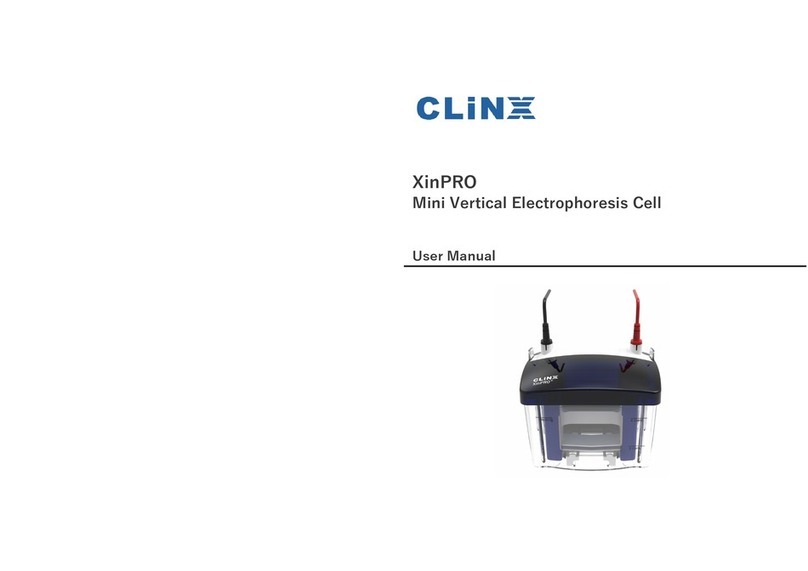
Clinx
Clinx XinPRO user manual
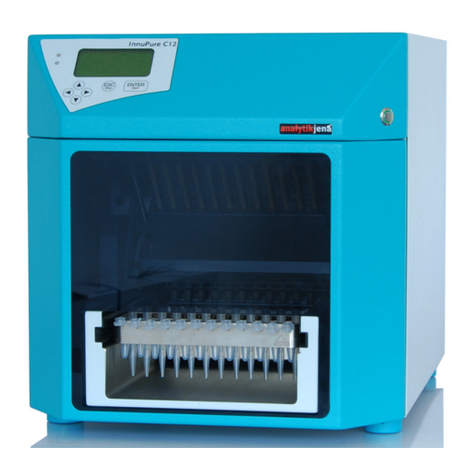
Analytik Jena
Analytik Jena aj CYBERTRON InnuPure C12 manual

Conrad
Conrad 97 52 27 operating instructions

Thermo Scientific
Thermo Scientific MaxQ Mini 4450 series Operating manual and parts list
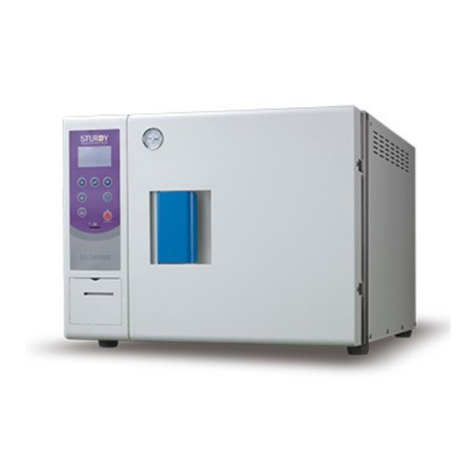
Apex Digital
Apex Digital STURDY SA-300MB instruction manual
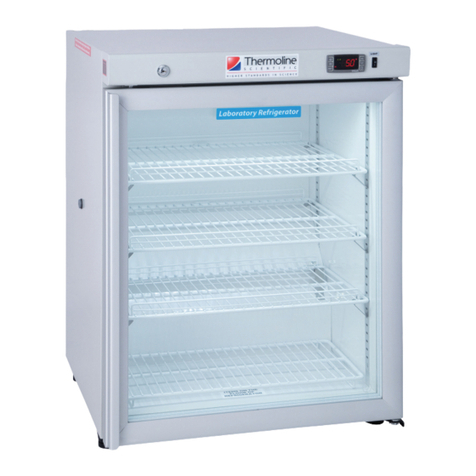
Thermoline Scientific
Thermoline Scientific TELR 130 instruction manual
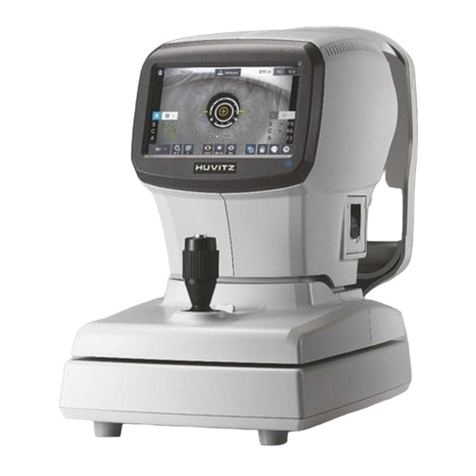
Huvitz
Huvitz CRK-7000 Service manual
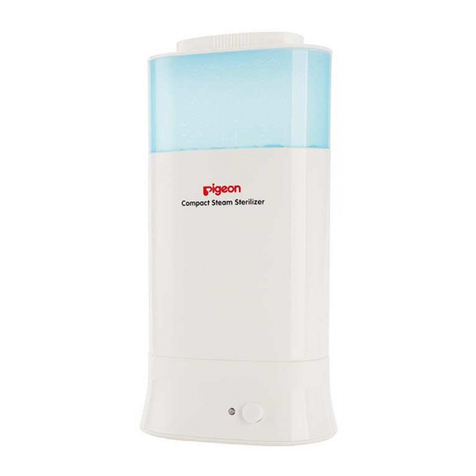
Pigeon
Pigeon 17504 instruction manual
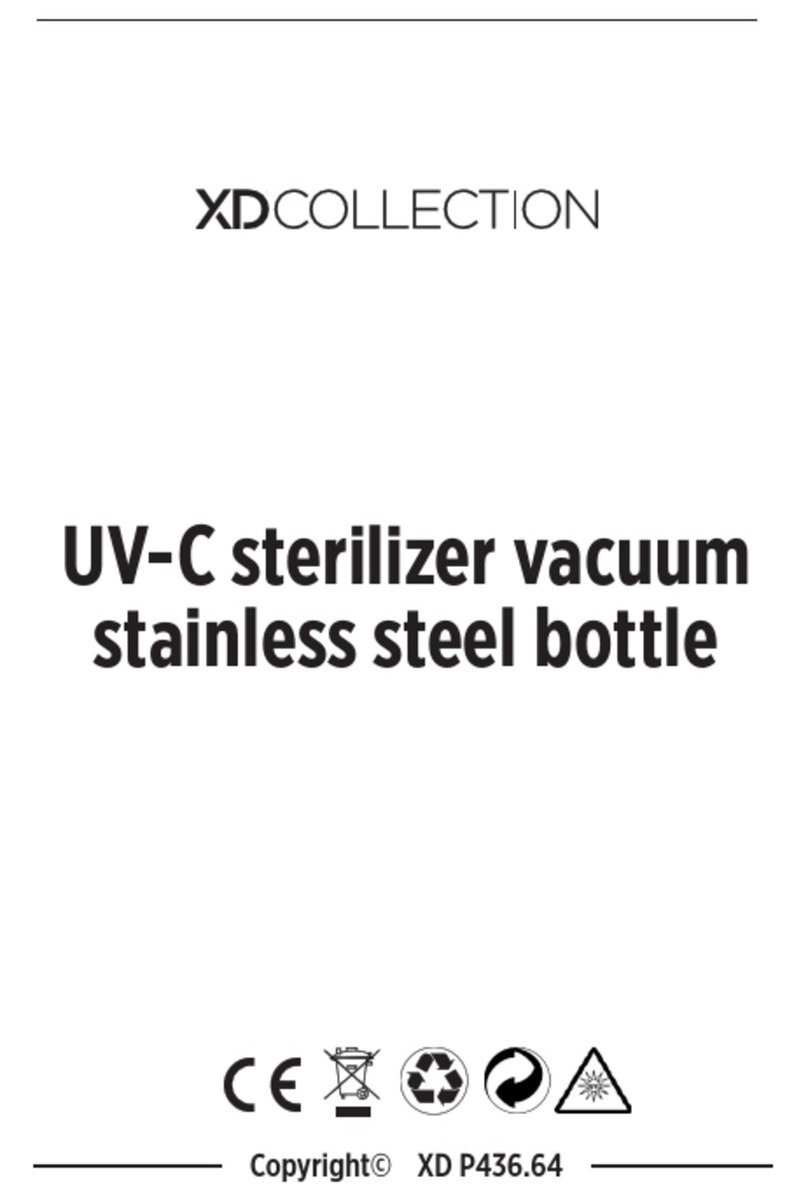
XD COLLECTION
XD COLLECTION P436.64 Instructions for use
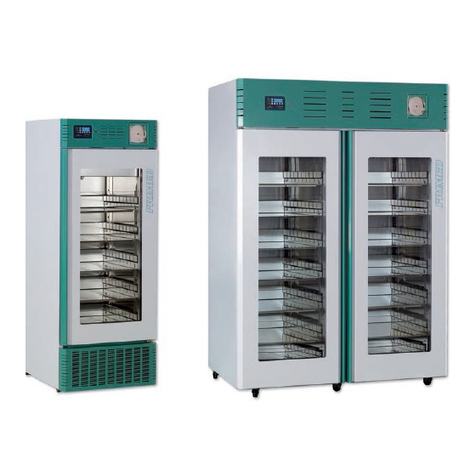
FRIMED
FRIMED SB10E Use and maintenance manual
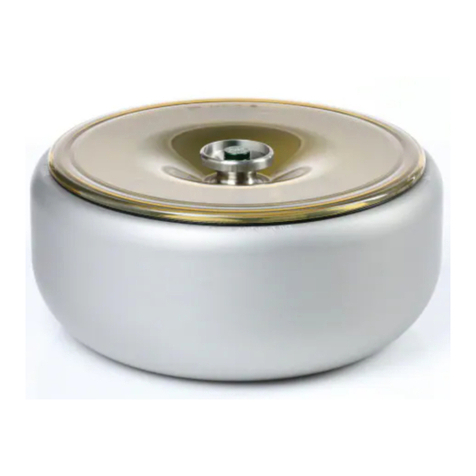
Thermo Scientific
Thermo Scientific BIOShield 1000A instruction manual
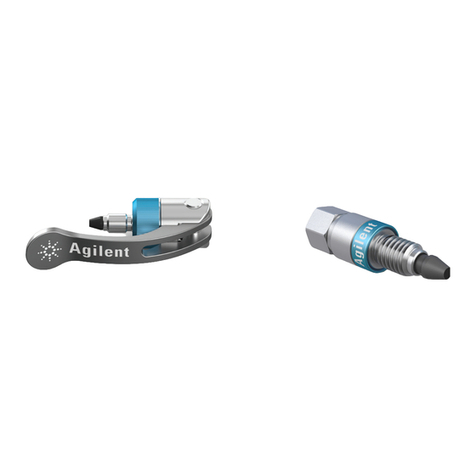
Agilent Technologies
Agilent Technologies ZORBAX RRHT Series user guide
